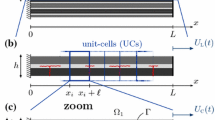Abstract
This paper deals with the experimental investigation and the numerical modelling of fibre mortar composite interface. This study focuses on the determination of failure types and the characterisation of mechanical behaviour at a fibre mortar-composite interface. The mechanical properties of fibre mortar are determined through laboratory tests. Experiments are carried out using a series of pull-out and shear tests to study the behaviour of composite/glue/fibre mortar assemblage. Numerical simulations based on the finite element method are used to predict the interface damage parameters as well as mixed mode crack initiation and propagation at the fibre mortar-composite interface. An interfacial decohesion model based on the indirect use of fracture mechanics is used to simulate the damage process. The model assumes a bilinear softening behaviour of the interfacial provided with stress-relative displacement laws. The interface parameters at the interface between fibre mortar and composite are evaluated and the failure mode determined.












Similar content being viewed by others
References
Cancelliere I, Imbimbo M, Sacco E (2010) Experimental tests and numerical modeling of reinforced masonry arches. Eng Struct 32:776–792
Voggu S, Sasmal S, Karusala R (2017) Numerical simulations for structural response of masonry arch bridge with relieving slab as upgradation strategy. Int J Civ Eng 1–16. https://doi.org/10.1007/s40999-017-0252-1
Mahini SS (2015) Smeared crack material modelling for the nonlinear analysis of CFRP-strengthened historical brick vaults with adobe piers. Constr Build Mater 74:201–218
Bednarz L, Górski A, Jasieńko J, Rusiński E (2011) Simulations and analyses of arched brick structures. Autom Constr 20:741–754
Rafiee A, Vinches M (2016) Implicit discrete element analysis of a masonry cupola under seismic loads. Int J Civil Eng 14(6):357–367
Aiello MA, Sciolti SM (2006) Bond analysis of masonry structures strengthened with CFRP sheets. Constr Build Mater 20:90–100
Serdar Camli U, Binici B (2007) Strength of carbon fiber reinforced polymers bonded to concrete and masonry. Constr Build Mater 21:1431–1446
Luccioni B, Rougier VC (2010) Shear Behaviour of brick–mortar interface in CFRP retrofitted or repaired masonry. Int J Mech Sci 52:602 – 611
Yuan H, Teng JG, Seracino R, Wu ZS, Yao J (2004) Full-range behavior of FRP-to-concrete bonded joints. Eng Struct 26:553–565
Fedele R, Milani G (2010) A numerical insight into the response of masonry reinforced by FRP strips, the case of perfect adhesion. Compos Struct 92:2345–2357
Fedele R, Milani G (2011) Three-dimensional effects induced by FRP-from-masonry delamination. Compos Struct 93:1819–1831
Capozucca R (2010) Experimental FRP/SRP–historic masonry delamination. Compos Struct 92:891–903
Kwiecien A, De Felice G, Oliveira DV et al (2016) Repair of composite-to-masonry bond using flexible matrix. Mater Struct 49:2563–2580
De Felice G, Aiello MA, Bellini A et al (2016) Experimental characterization of composite-to-brick masonry shear bond. Mater Struct 49:2581–2596
Zou Z, Reid SR, Li S (2003) A continuum damage model for delaminations in laminated composites. J Mech Phys Solids 51:333–356
Allix O, Ladevèze P, Corigliano A (1995) Damage analysis of interlaminar fracture specimens. Compos Struct 31:61–74
Jin CF, Zhu QZ, Shao JF (2014) A numerical analysis of interface damage effect on mechanical properties of composite materials. Mech Res Commun 62:18–24
Hu N, Zemba Y, Fukunaga H, Wang HH, Elmarakbi AM (2007) Stable numerical simulations of propagations of complex damages in composite structures under transverse loads. Compos Sci Technol 67(3–4):752–765
Chen J, Crisfield M, Kinloch AJ, Busso EP, Matthews FL, Qiu Y (1999) Predicting progressive delamination of composite material specimens via interface elements. Mech Compos Mater Struct 6(4):301–317
Kim JJ, Fan T, Reda Taha MM, Shrive NG (2012) The effect of damage and creep interaction on the behaviour of masonry columns including interface debonding and cracking. Mater Struct 45:15–29
Wang J (2006) Debonding of FRP-plated reinforced concrete beam, a bond-slip analysis. I. Theoretical formulation. Int J Solids Struct 43:6649–6664
Choi KK, Meshgin P, Reda Taha M (2007) Shear creep of epoxy at the concrete–FRP interfaces. Compos B 38:772–780
NF EN 13286-43 (2003) Mélanges traités et mélanges non traités aux liants hydrauliques. AFNOR
SikaCarboDur (2009) Systèmes de renforcement structuraux, Technologies et concepts. Documentation Technique SIKA, No 9.14
NF EN 1542 (1999) Produits et systèmes pour la protection et la réparation des structures en béton. Mesurage de l’adhérence par traction directe
Ceroni F, de Felice G, Grande E, Malena M, Mazzotti C, Murgo F, Sacco E, Valluzzi MR (2014) Analytical and numerical modeling of composite-to-brick bond. Mater Struct 47:1987–2003
Ferrier E, Quiertant M, Benzarti K, Hamelin P (2010) Influence of the properties of externally bonded CFRP on the shear behaviour of concrete/composite adhesive joints. Compos Part B 41:354–362
Benzerga D, Haddi A, Seddak A, Lavie A (2008) A mixed-mode damage model for delamination growth applied to a new woven composite. Comput Mater Sci 41:515–521
Kesteloot S, Djelal C, Baraka S, Benslimane I (2005) Finite-element modelling of concrete prisms reinforced with composites plates-theory of cracking. Mater Struct 38:219–227
Aiello MA, Galati N, La Tegola A (2000) Collapse load of masonry arches strengthened with FRP sheets. In: Proceeding of the first national conference on mechanics of masonry structures strengthened with FRP materials: modelling, testing, design, control, 75_84
Valluzzi MR, Valdemarca M, Modena C (2001) Behavior of brick masonry vaults strengthened by FRP laminates. J Compos Constr ASCE 5(3):163–169
Luciano R, Marfia S, Sacco E (2002) Reinforcement of masonry arches by FRP materials. In: ICCI’02, International Conference on FRP composites in infrastructures
Author information
Authors and Affiliations
Corresponding author
Rights and permissions
About this article
Cite this article
Kesteloot, S., Haddi, A. & Djelal, C. Experimental and Numerical Investigations of Damage Behaviour at the Fibre Mortar Composite Interfaces. Int J Civ Eng 16, 1523–1532 (2018). https://doi.org/10.1007/s40999-018-0287-y
Received:
Revised:
Accepted:
Published:
Issue Date:
DOI: https://doi.org/10.1007/s40999-018-0287-y




